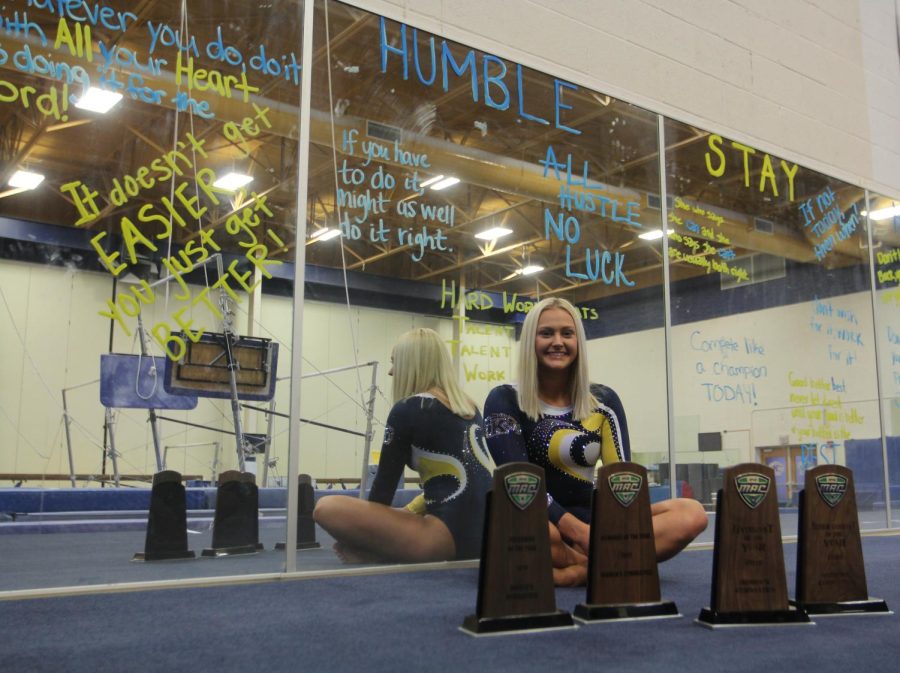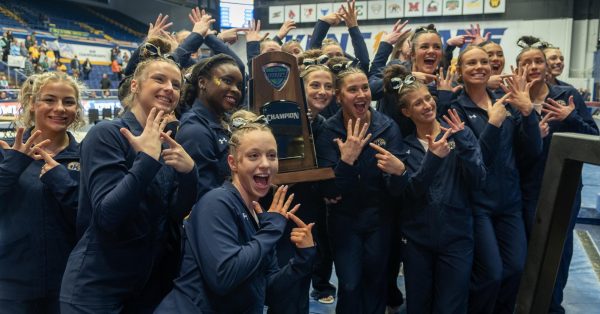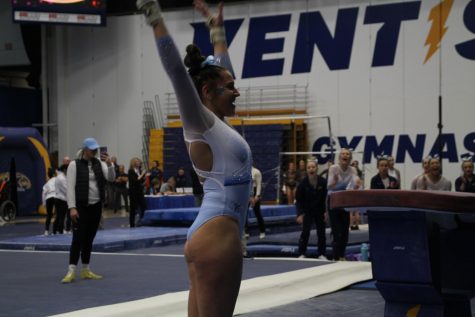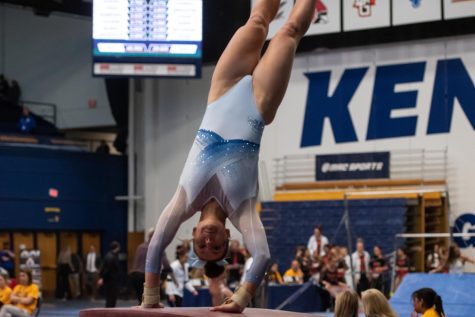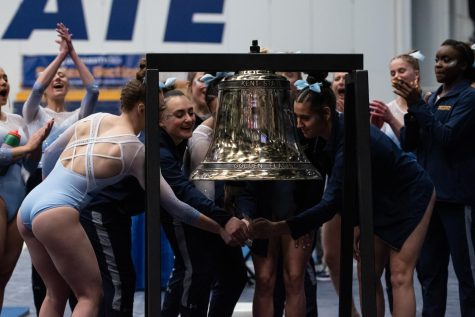Stay Humble, Stay Hungry, Stay Stypinski:
April 26, 2018
When Rachel Stypinski was 3 years old, she would jump from couch to couch in her family room in Gilbertsville, Pennsylvania.
She had so much energy that her mother knew she had to do something — anything — to keep Rachel active and occupied.
The answer, Marci Stypinski decided:
Gymnastics, a sport Marci had competed in at college at Temple University in Philadelphia.
For Rachel, that started a 20-year career that took her to Kent State, where she will graduate in May as one of the best gymnasts in school history. She is a three-time Mid-American Conference gymnast of the year.
From the floor of her home, Rachel went to Silvia’s Gymnastics, which trained girls from ages 3 to to 18 for competition. And since, she has spent her life upside down as much as right side up.
From the start, Marci said, “Rachel loved it, and it was really good for her as far as coordination, balance and to get rid of some energy.”
Within a year, Rachel’s mother knew gymnastics would be far more than a hobby for her daughter.
By the time Rachel was 10, she was winning multiple events at USA Gymnastics league meets, advancing faster than anyone expected.
“I always loved the competitiveness of the sport,” Stypinski said.
Rachel loved learning the routines, competing against people as good as she was and meeting people who also loved swinging and flipping.
“I started becoming successful in fourth grade,” Stypinski said. “I began [exceeding] my expectations and my coaches. My skills were increasing quickly. But even at that age, I tried really hard to stay level-headed and not be cocky.”
The leaps and the tumbling came easy. The mental aspect came harder.
Her mind started to get in the way of her body.
There were times when she would get ready to do a cartwheel but couldn’t convince herself to start to put her hands on the mat.
The struggle came and went. Just days after freezing, she could go out and win a regional meet.
But things got so bad that in high school, Rachel didn’t compete on the vault for three years. Sometimes in practice she would refuse to do bars — one of her best events.
Her parents didn’t know what to do.
“No matter what I said, I couldn’t help,” Marci said.
They went to multiple sports psychologists and a hypnotist before they found one who taught her to “visualize,” to see herself perform her routines before she did them.
Rachel didn’t compete her whole senior year until the state championship meet.
Then she went out and won it.
Rachel started hearing from college coaches even before high school. In eighth grade, she met Craig Ballard, then an assistant coach at Bowling Green. A year later he was hired at Kent State and began to talk up his new school to her.
In her sophomore year in high school, Rachel blew out her left ankle while performing a double backflip in a tumbling pass in practice. The injury sidelined her for months, and the college coaches called less often.
Kent State kept in touch, and when Rachel returned to competition the next fall, she was better than ever. Some national gymnastics powerhouses — Utah, LSU, Penn State — contacted her then.
But Kent State had stayed loyal to her throughout her time off. When Rachel attended a Flashes practice on an unofficial visit, she said she could tell the team was having fun, and it wasn’t “forced fun.”
“The coaches reminded me of my home coaches that I grew up with,” she said.
Stypinski’s mom also liked Kent State immediately.
But the biggest factor about her decision came when her dad sat down with her and asked, “Do you want to be a little fish in a big pond or a big fish in a little pond?”
“I want to make a difference,” she told him.
Kent State coach Brice Biggin knew from the start Stypinski was going to be special.
The Stypinski File
-
Three-time MAC gymnast of the year
-
Co-MAC freshman of the year
-
MAC specialist of the year
-
MAC all-around champion
-
MAC champion on bars and beam
“She was so talented,” Biggin said. “She was a kid that was going to do all four events, but her tumbling and beam were phenomenal.”
College, though, was an adjustment.
Club gymnastics, Stypinski said, was all about individual skill and performance. She had to adjust to the team component of college gymnastics.
In college, Stypinski said, gymnastics “is an individual sport, but you still have the team aspect of it.” There are no team scores in club gymnastics; at Kent State, Biggin sometimes doesn’t even want to talk about individual performances if the team loses. In interviews, Stypinski usually talks about her teammates before she talks about herself.
Biggin said at first Stypinski wanted to train at practice like she did in club — setting her own pace and standards. But Biggin wanted intensity all the time.
“I could be stubborn,” Stypinski said, and it took her awhile to adjust to the practices expected at Kent State.
“Once she intensified her practices, she became one of the most consistent gymnasts in the gym,” Biggin said.
Stypinski’s mental blocks followed her to college at first.
“We knew she struggled mentally sometimes,” Biggin said.
But, the coach told her, “bulking” — freezing in the middle of a skill — can cause serious injuries. And if a gymnast did it in practice, the whole team had to do push-ups and suicide sprints. Not letting her teammates down kept her on track.
Biggin could see every day Stypinski was working to overcome the mental blocks. Each practice it seemed to get easier.
Stypinski relied on the visualization she had learned.
“At practice, I just try to have fun with the team so that way I don’t think too much,” Stypinski said. “When I think too much, the mental blocks come back.”
“As her coach, I knew patience was key in the situation,” Biggin said. “By the time the season came around her freshman year, we really never had problems with it.”
Each year things improved. Stypinski said she would still get nervous about dismounts and slip once in a while. At her final event in regional competition, she did her dismount without having practiced it for a week because of an injury.
But she pulled it off.
Physical struggles were perhaps worse in college. Like all gymnasts, Stypinski was often hurt; she counts seven injuries in her career that resulted in casts or surgeries.
Her first big injury was a stress fracture in her foot in eighth grade.
She missed eight months because of the ankle injury in her sophomore year.
She missed the MAC Championships her sophomore year because of a concussion.
She missed the conference meet again this season because of the worst injury in her career.
It came on the last event during her last competition on her home floor at the M.A.C. Center. On the floor exercise on Senior Night, Stypinski was doing the same powerful double backflip in a laid-out position she was doing when she was hurt badly in high school.
This time the other ankle gave way. Stypinski fell to the mat and cried out. She lay on the floor for minutes while trainers worked on her, eventually calling a gurney and an ambulance. The crowd — many of whom had watched her perform for her whole college career — sat silently. Her parents were among them.
Other gymnasts, fans and other MAC schools believed Stypinski’s gymnastics career had come to an end.
She didn’t.
She left the hospital the night after the meet on crutches. She was still on them and wearing a walking boot when she watched and cheered on her teammates at the MAC Championships.
Stypinski in the record books
-
All-around: 39.575 – third in school history
-
Beam: 9.975 – second in school history
-
Bars: 9.950 – tied for first in school history
-
Floor: 9.975 – tied for second in school history
But doctors cleared her to try to compete on the bars in the NCAA Regional meet two weeks later. Bars could work, they decided, because bars was almost entirely swinging with her arms; the only time her foot hit the mat was when she landed — the move she never practiced leading up to the meet.
“Every day I iced my ankle, wore a walking boot and kept it elevated,” Stypinski said. “I tried to do my best to get the swelling down and to strengthen it.”
“It was one of the hardest things I have ever faced,” she said. “But it made me realize a lot about myself, that an injury doesn’t define you.”
She did her last routine at NCAA Regionals, ending with a stuck landing and cheers from Kent State’s team. She scored a 9.800, not her highest score ever.
But she said it is her fondest gymnastics memory.
“Sticking the landing and ending on a high note is something I will never forget,” Stypinski said.
“Rachel has brought the level of Kent State gymnastics up as far as expectations,” Biggin said. “When you hear her talk, it is never about herself. It is always about the team. That’s one of the rare things that comes from an athlete as special as her.”
The team’s motto this season — developed by Stypinski and the other seniors — was, “Stay Humble, Stay Hungry.”
Her teammates say Stypinski exemplifies the words.
“She motivates everyone around her to work just as hard as she does,” said senior Michaela Romito, Stypinski’s best friend.
Stypinski’s excitement shows when she sticks a routine. But she shares the same excitement when a teammate hits a dismount or the team celebrates a win.
Freshman Abby Fletcher said Stypinski was the exact role model she needed this year to guide her through her first season.
“I looked up to Rachel a lot in the gym,” Fletcher said. “I just observed how she handled practices and tried to figure how she was so successful.”
Stypinski wants to help future gymnasts after she graduates, but not necessarily as a coach.
She will be graduating this spring with a degree in criminal studies and a minor in psychology. She hopes to attend grad school at Kent State or Auburn to study clinical mental health counseling.
Because she struggled mentally at times, Stypinski wants to help others through it.
Stypinski leaves Kent with a pile of all-around titles, high scores and MAC titles. But when asked “What legacy do you hope to leave behind?” she sighed and said quietly, “Wow. That is a hard question.”
Finally, she said:
“As a team I wanted to show that we can compete against those bigger teams and higher our level of gymnastics. I hope that is my legacy.”
Libby Schrack is a sports reporter. Contact her at [email protected].


